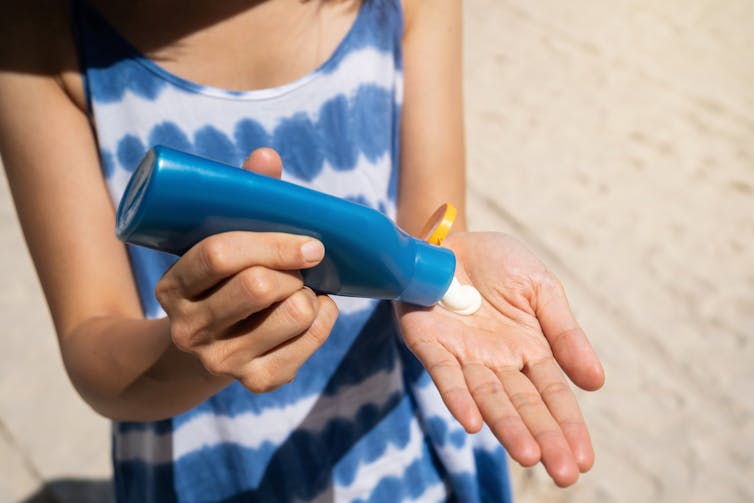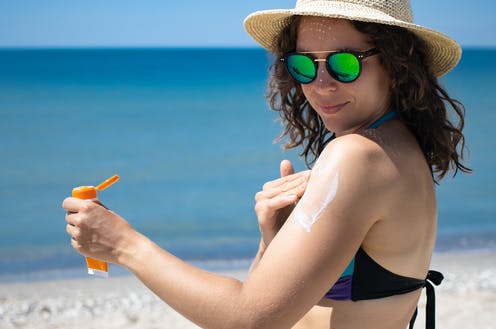Summer is around the corner, so it’s time to get out the sun cream. While most sun creams do a pretty good job of protecting against harmful damage caused by the sun’s ultraviolet (UV) rays, our recent study suggests they could be made even better. We found that adding a particular class of antioxidant (a type of molecule thought to help prevent or slow cell damage) to sun creams could help provide more powerful protection against damage from one type of UV radiation than existing ingredients.
The sun emits three types of ultraviolet radiation: UVC, UVB and UVA. Each of these is harmful, but the most harmful are UVC and UVB. Thankfully, the ozone layer stops many of the harmful rays reaching the Earth’s surface. Many, but not all. Around 95% of the UV rays that reach the Earth’s surface are UVA, but around 5% are the more harmful UVB rays.
Both UVA and UVB are dangerous types of radiation. UVB directly damages the DNA in your skin cells, while UVA causes indirect damage by generating harmful “free radicals”. These are molecules that can damage the skin cells’ fat, protein and DNA. Over time, the cumulative effects of sun damage can lead to irreversible harm to the skin and may increase the risk of developing skin cancer.
Everyone is at risk of sun damage, regardless of skin type. While people with light skin are more vulnerable to UVB, all skin types appear to be equally sensitive to UVA rays. So people with darker skin can still experience sun damage, especially from UVA rays.
When most of us go out in the sun, we tend to use sun creams to protect our skin from these harmful rays. Most of these contain either physical sun blockers (such as titanium dioxide or zinc oxide) or chemical filters, which most of us know better as sunscreen.
Physical sun blockers act by scattering or refracting the sun’s rays, while the chemicals in sunscreens absorb the sun’s UV radiation then convert it into a less damaging form that won’t harm skin cells.
In recent years, some sun creams have also begun adding antioxidants, such as vitamins C and E, to neutralise free radicals and protect against UVA radiation. They’re added to act as a second line of defence in case the sun blockers or sunscreens the product contains fail.
But while this sounds promising, many studies have shown that these antioxidants only have a very modest protective effect when added to sun creams. This is because UVA radiation has a dual damaging effect on skin cells by generating both free radicals and free reactive iron.
Free reactive iron is a dangerous form of iron – different from the nutrient iron that is necessary for the body’s function – that can generate a type of very harmful free radical with even more damaging power towards skin cells. Vitamins C and E haven’t been shown to be effective against free iron.
However, our recent research in human skin cells showed a particular class of antioxidants found in fruit and bark has a dual protective effect against damage from UVA rays. Our study showed that this type of antioxidant was able to both neutralise free radicals and trap free reactive iron, which both build up in the skin when exposed to UVA radiation. So adding these antioxidants to sun creams could provide a more effective second line of defence.

kitzcorner/ Shutterstock
The next step in our research will be to understand how we can improve the shelf life of these antioxidants so they remain active for a long time in sun creams. It will also be important for researchers to test whether these antioxidants offer the same level of protection when tested on humans.
This isn’t to say that current sun creams on the market don’t still provide important protection from some of the harm caused by the sun – they certainly do, so be sure to stock up on them.
How to protect yourself
To get the best protection from the sun, it’s best to avoid going out in the sun between 11am and 3pm. However, if being out in the sun is unavoidable –- because of your occupation, for example – then you need to cover as much of your skin as possible and stay in the shade if you can.
Also, be sure to use the right amount of sun cream, which is 2mg of sun cream per centimetre square of skin. This is equivalent to two tablespoons of sun cream altogether for the face and body while wearing a swimming costume. But most people often use about a quarter of this amount or even less when they apply their sun cream, meaning they might be missing out on its protective effect.
It’s also important to choose the right SPF (sun protection factor). For very light skin, use products with a high SPF (SPF 50 or higher) that has a five-star UVA protection factor (UVA-PF), which will be listed on the bottle.
For darker skin, SPF 30 and above with a five-star UVA-PF is recommended. For any SPF values of 30 or more, look for a UVA logo on the bottle that has a circle around it. This means that the product meets the EU standard and has protection against both UVA and UVB rays.
![]()
Dr. Charareh Pourzand consults for ASEA LLC. The consultancy work delivered by Dr. Pourzand is facilitated by Consultancy Services in Research and Innovation Services (RIS) at the University of Bath. She has received funding from ASEA LLC, British Skin Foundation and BBSRC to conduct some of the work cited in this article.











